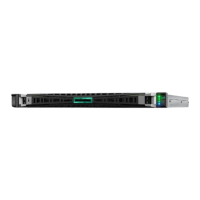Mission
Critical
Transaction
al
Application
Processing
High
Performanc
e Compute
(HPC)
Decision
Support
Graphic
Processing
I/O
Throughput
NUMA Group
Size
Optimization
X Clustered Clustered Clustered Clustered Clustered
Thermal
Configuration
X X X X X X
Memory
Patrol
Scrubbing
X X X X X X
Memory
Refresh Rate
2X X 1X X X X
Memory Bus
Frequency
X X X X X X
Applying a Workload Profile
You apply a Workload Profile to have the system manage your workload according to predefined settings
provided with the system. Dependent options cannot be changed and are grayed out. You can change
any nondependent options in a profile.
Procedure
1. From the System Utilities screen, select System Configuration > BIOS/Platform Configuration
(RBSU) > Workload Profile.
2. Select a Workload Profile.
3. Optional: Change any nondependent options that you want to change.
4. Save and reboot to apply your Workload Profile.
More information
Workload Profiles and performance options on page 44
Changing dependent options after applying a profile
There may be one or more dependent options that you want to change in your Workload Profile.
Dependent options cannot be changed for a predefined profile. You can change the dependent options in
Custom mode. When you are in Custom mode, your deployment is no longer in profile mode and you can
manually adjust option settings. When you enter Custom mode, all the settings from the previously
applied profile are shown.
The easiest way to change dependent settings is to modify an applied profile. First apply a Workload
Profile that has most of the settings that you want to use then change to Custom mode. Then change only
the settings you want to have new values.
Prerequisites
Apply a Workload Profile before you do this task.
52 Applying a Workload Profile

